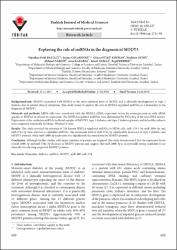Exploring the role of miRNAs in the diagnosis of MODY3

View/
Access
info:eu-repo/semantics/openAccessDate
2018Author
Baltacı, Oğuzhan FatihÇolakoğlu, Şeyma
Güllü Amuran, Gökçe
Aydın, Neslihan
Sargın, Mehmet
Karabay, Arzu
Yılmaz, Temel
Berber, Ergül
Metadata
Show full item recordCitation
Baltaci, O. F., Colakoglu, S., Gullu Amuran, G., Aydin, N., Sargin, M., Karabay, A., . . . Berber, E. (2018). Exploring the role of miRNAs in the diagnosis of MODY3. Turkish Journal of Medical Sciences, 48(3), 620-+. doi:10.3906/sag-1711-98Abstract
Background/aim: MODY3 associated with HNF1A is the most common form of MODY and is clinically misdiagnosed as type 1 diabetes due to similar clinical symptoms. This study aimed to analyze the role of HNF1A-regulated miRNAs as a biomarker in the diagnosis of MODY3. Materials and methods: MIN6 cells were transfected with the HNF1A cDNA expression vector for overexpression or with siRNA specific to HNF1A to silence its expression. The HNF1A-regulated miRNAs were determined by RNA-Seq of the total RNA extract. Expressions of the candidate miRNAs in blood samples of MODY3, type 1 diabetes, and type 2 diabetes patients and in healthy subjects were compared statistically by Mann-Whitney U tests.Results: This study revealed the presence of 238 known HNF1A-regulated miRNAs in MIN6 cells. miR-129-1-3p, miR-200b-3p, and miR-378a-5p were selected as candidate miRNAs. The expression level of miR-378a-5p significantly decreased in type 2 diabetes and MODY3 patients, while miR-200b-3p expression was significantly decreased only in MODY3 patients. Conclusion: Although further studies with larger numbers of patients are required, this study demonstrated that the expression levels of miR-200b-3p and miR-378a-5p decrease in MODY3 patients and suggests that miR-200b-3p is an especially strong candidate to use clinically for selecting suspected MODY3 patients.

















